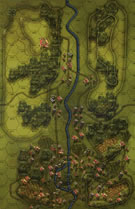|
First In, Last Out Swallows of Death #30 |
||
|---|---|---|
| (Attacker) Germany | vs |
France
(Defender)
Morocco (Defender) |
| Formations Involved | ||
|---|---|---|
| France |  |
4e Régiment de Spahis Marocains |
| Germany |  |
Groupe Schmid-Dankward |

|
| Overall Rating, 0 votes |
|---|
|
0
|
| Scenario Rank: --- of 957 |
| Parent Game | Swallows of Death |
|---|---|
| Historicity | Historical |
| Date | 1940-06-24 |
| Start Time | 16:00 |
| Turn Count | 16 |
| Visibility | Day |
| Counters | 72 |
| Net Morale | 0 |
| Net Initiative | 1 |
| Maps | 1: 30 |
| Layout Dimensions | 43 x 28 cm 17 x 11 in |
| Play Bounty | 216 |
| AAR Bounty | 222 |
| Total Plays | 0 |
| Total AARs | 0 |
| Battle Types |
|---|
| Bridge Control |
| Delaying Action |
| Inflict Enemy Casualties |
| River Crossing |
| Conditions |
|---|
| Anti-tank Ditches |
| Minefields |
| Off-board Artillery |
| Severe Weather |
| Terrain Mods |
| Joint Forces Battle |
| Scenario Requirements & Playability | |
|---|---|
| Fall of France 2 | Maps + Counters |
| Swallows of Death | Base Game |
| Introduction |
|---|
|
Annonay, south of Lyon. The 1st Spahis Brigade had been the first to fight the Germans in Luxembourg in May. With the end of the Battle of France closing in, the Brigade was dispatched to Savoie, west of the Alp mountains. There, it stood on the west bank of the Rhône River valley, charged with delaying the German advance to the south. While the 6th Algerian Spahis watched the roads close to the Rhône, the 4th Moroccan Spahis set up roadblocks in the hilly region to the west, along the Cance River ravine. Calm at first, the sector grew lively as the German attacks along the Rhône River failed. |
| Conclusion |
|---|
|
The Germans at first managed to gain a foothold, but soon enough the Spahis forced them back. Two more German attacks at 1700 and 1800, covered by heavy mortar fire, failed to make any headway despite desperate, hand-to-hand fighting. When darkness fell the French pulled back. Exhausted, the Germans did not pursue and fell back as well. During the night, an order arrived confirming the cessation of hostilities, and the Spahis headed for the Swiss border where they crossed into internment. They later returned to Vichy France, and in 1943 joined the Free French movement. |
| Additional Notes |
|---|
|
Swallows of Death may be played with the 1st edition pieces and maps from 1940: Fall of France. Special Rule nr 4 is missing. The rule is: (Optional) Deep Ravine. The river is minor but it flows in a deep ravine. Treat river hexes as a 20m depression and limiting terrain. Units entering river hexes from non-river hexes pay the following movement costs; Foot 2, Motorized Prohibited, Mechanized 6. Units entering river hexes from river hexes pay the normal movement costs. Units moving onto a river hex that contains a bridge have two options: they can pay the road movement costs to use the bridge or they can pay the movement costs outlined above to be in the depression. Units that use the bridge are at ground level. Units in the depression benefit from a 1 column left shift (-1) when they are the target of direct or anti-tank fire and have first fire when defending in assault. |
| AFV Rules Pertaining to this Scenario's Order of Battle |
|---|
|
| 4 Errata Items | |
|---|---|
| Scen 30 |
Special rule nr 4 is missing. Here it is: (Optional) Deep Ravine. The river is minor but it flows in a deep ravine. Treat river hexes as a 20m depression and limiting terrain. Units entering river hexes from non-river hexes pay the following movement costs; Foot 2, Motorized Prohibited, Mechanized 6. Units entering river hexes from river hexes pay the normal movement costs. Units moving onto a river hex that contains a bridge have two options: they can pay the road movement costs to use the bridge or they can pay the movement costs outlined above to be in the depression. Units that use the bridge are at ground level. Units in the depression benefit from a 1 column left shift (-1) when they are the target of direct or anti-tank fire and have first fire when defending in assault. (leonard
on 2023 Dec 05)
|
| Scen 30 |
Per Philippe: Optional Special Rule #4 (or AP forgot to delete the reference...). The rule is: (Optional) Deep Ravine. The river is minor, but it flows in a deep ravine. Treat river hexes as a 20m depression and limiting terrain. Units entering river hexes from non-river hexes pay the following movement costs; Foot 2, Motorized Prohibited, Mechanized 6. Units entering river hexes from river hexes pay the normal movement costs. Units moving onto a river hex that contains a bridge have two options: they can pay the road movement costs to use the bridge or they can pay the movement costs outlined above to be in the depression. Units that use the bridge are at ground level. Units in the depression benefit from a 1 column left shift (-1) when they are the target of direct or anti-tank fire and have first fire when defending in assault. (Juiceman
on 2023 Dec 06)
|

|
The reduced direct fire value of the Heer HMG became 5-5 starting with Fall of France. (plloyd1010
on 2015 Jul 31)
|

|
The morale and combat modifiers of German Sergeant #1614 should be "0", not "8". (Shad
on 2010 Dec 15)
|

 SwlD029
SwlD029 





























